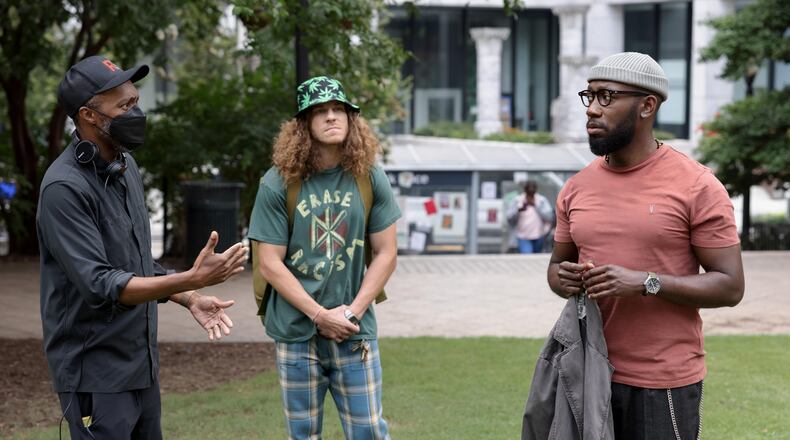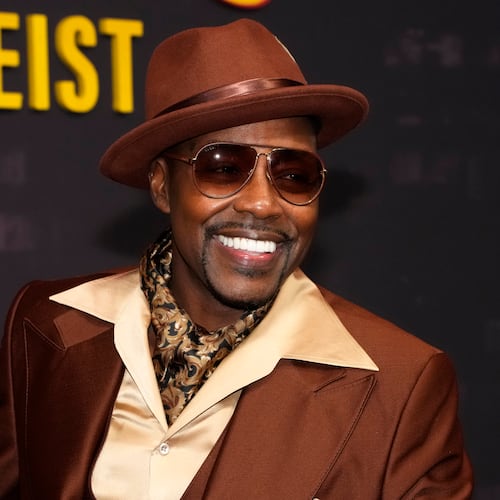When Georgia passed its very generous tax credits to draw more TV and film projects to the state in 2008, it took time to attract and build a base of crew members but there are now an ample number of hairstylists, camera operators and caterers to handle 50 or more active productions at once.
It has taken more time for actors, directors and producers to move to Georgia but it’s happening gradually.
Maurice Marable, an Emmy-nominated director, is one of those transplants. He moved back to Atlanta in 2018 after 20-plus years in Brooklyn. He and his wife had a daughter later in life and wanted her to be around family since both have siblings in Atlanta. But the city was also where Marable was shooting an IFC show at the time, “Brockmire” with Hank Azaria.
And Marable was able to come home every night while shooting Hulu’s “Woke,” which moved its second season to Atlanta and debuted earlier this month on the streaming service. He also helped with another production shot in New Orleans, the new Peacock comedy “Killing It” starring Craig Robinson of “The Office” fame.
Marable’s film career started when he was attending Georgia State University in the early 1990s. There, he heard that Morehouse College graduate Spike Lee was executive producing a 1994 film “Drop Squad,” which was shot in part in Atlanta. He begged to become a production assistant but instead became an intern.
“Producers took a liking to me,” he said. “They asked me to drive a truck to New York to drop off stuff. I then became a production assistant for post production. I went from talking about Spike Lee in class to working with him in the edit room.”
He dropped out of GSU and was soon traveling the world shooting music videos with Michael Jackson as a production supervisor. He spent years as creative director at HBO producing promos for TV shows like “The Sopranos” and “Sex and the City.” He later directed commercials but would help out HBO whenever they asked. “It was like family to me,” he said.
In 2014, he shot a seven-minute comedic short film featuring “Veep” star Julia Louis-Dreyfus and actual vice president Joe Biden for the White House Correspondents Dinner. It featured cameos from Michelle Obama and Nancy Pelosi. The buzz from that video led to calls for him to direct all sorts of shows, from “It’s Always Sunny in Philadelphia” and “Insecure” to episodes of “Veep.”
“Woke” stars Lamorne Morris as Keef, a Black San Francisco-based cartoonist on the verge of mainstream success who in season one gets roughed up by the police after being mistaken for a robber. The trauma triggers his “wokeness” enabling inanimate objects like beer cans, a garbage can and his marker to talk to him about social injustice. Marable is an executive producer and director.
Season one was shot in Vancouver, which hugs the ocean and has enough hilly terrain to masquerade as San Francisco. But season two was shot in metro Atlanta. The city, Marable admits, is not so ideal given its relatively flat terrain and lack of ocean access.
“We were very judicious about where we shot,” Marable said. “Any time we found a hill, we used it. It was a challenge, brother, a real challenge... We have some footage from last season. Hopefully, people will feel like they’re in San Francisco.”
Marable pushed for the move because he found Atlanta more reflective of American diversity. Three of the four lead characters on “Woke” are Black and many of the writers and producers are Black.
“Vancouver was a great location for us,” he said. “But the challenge I had there was no diversity.”
Vancouver, which is about 48% Asian, is only 1% Black. San Francisco is 34% Asian while the Black population is about 5%. Metro Atlanta is about 33% Black and 7% Asian.
Marable does a wink and nod toward the Atlanta connection in the first episode by namedropping Stacey Abrams and Killer Mike attending a protest held at a park, which is actually Woodruff Park in downtown Atlanta.
Credit: Joe Lederer
Credit: Joe Lederer
Keef is loosely based on Keith Knight, a real cartoonist who was traumatized by a negative cop experience himself and became a cartoon activist focused on police brutality. “He has a wicked sense of observational humor,” Marable said. “It’s based on his mind and some of the journeys he’s been around.”
The fictional Keef doesn’t talk as much to his inanimate objects season two. “He was going through trauma last season,” Marable said. “The inanimate objects helped him through his trauma. The animation got less and less over time. By the end of season one, there was none except marker [voiced by J.B. Smoove]. That’s the one thing that communicates with him on a regular basis: his art.”
This season, Keef has become “a celebrity of wokeness and the spotlight is on him,” Marable said. “How do you stay woke when people are fanning you?”
In season two, a wealthy entrepreneur funds Keef’s initiatives. “Who are you working for and what is your agenda?” Marable said. “Are you changing your agenda to appease corporate dollars? We saw after George Floyd a lot of companies jumped on the Black Lives Matter bandwagon. Business co-opting wokeness for money. In the end, it was a marketing tool for a lot of them. We dive into that.”
Morris, in a separate interview, said Keef “changes with the wind and that’s not necessarily a good thing. You have to stand your ground and find what you’re passionate about. Is Keef’s activism performative or isn’t it? He has the microphone now. What’s he going to do with it?”
The show is neither a full embrace nor a searing indictment of the concept of “wokeness.” Marable acknowledges the word “woke” was once a positive concept that has since been co-opted by conservatives as everything that is wrong with America.
“Every time I say the word woke, it’s weird,” Marable said. “Our goal is to satirize the idea of wokeness and celebrate when it’s right and call it out when it’s wrong. Can you ever really be woke, really? What does it mean? It seems to change. To me, woke is the moral obligation to do the right thing. But today, it’s been twisted like the phrase ‘fake news.’”
Keef has three tight friends, all around 30 years old, and the second season feels more like an ensemble comedy, which was by design.
Gunther (Blake Anderson) is one of Keef’s roommates and an old college bud, an easygoing hippy white dude struggling to be a supportive ally in the cause. “At the end of the day, the essence of Gunther is he wants to be the best friend possible to Keef,” Anderson said.
T. Murph plays Clovis, his other roommate, who is both fast talking and super confident. The actor spent the pandemic working out so much, he ended up with such an impressive six pack the show incorporated that into Clovis.
“He’s trying to be little Black Ant Man,” Marable joked. “He was obsessed in real life so we used it.”
“I didn’t know what was going to happen,” T. Murph said. “I was getting ready for zombies. I was working out on playgrounds doing chin ups on jungle gyms.”
Sasheer Zamata’s Ayana, who was Keef’s “woke” guide in season one, has her own issues season two. Her newspaper is stumbling for financial reasons, so she moves in with the dudes. She also exhibits “woke” fatigue.
“She came off season one as having it together,” Zamata said. “We now see her needing help. It’s nice to see her with cracks and insecurities. That’s real.”
WHERE TO WATCH
“Woke,” available on Hulu and “Killing It,” available on Peacock
About the Author
Keep Reading
The Latest
Featured





